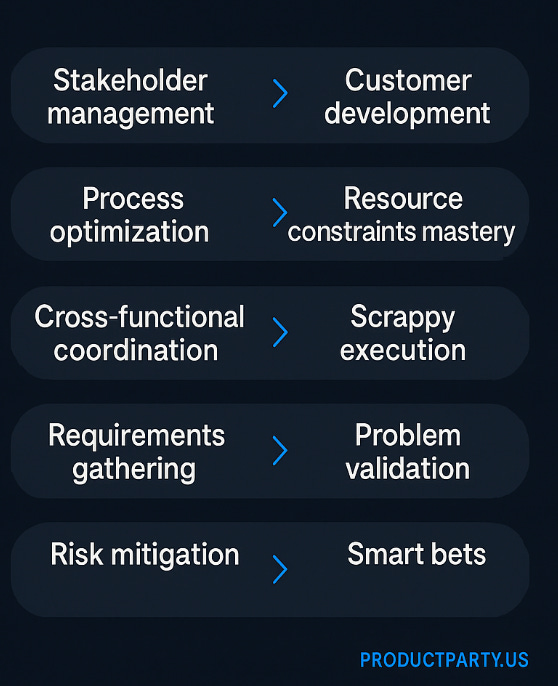Your corporate experience is startup currency.
How to reframe Fortune 500 skills for 0 > 1 environments.
That moment when you realize your enterprise PM experience might actually be startup gold. You just need to know how to translate it.
The skills that make you valuable at a Fortune 500 company aren't irrelevant at a startup. They're just applied differently.
The gap isn't about learning entirely new capabilities - it's about reframing the ones you already have.
In fast-moving environments where every hire matters, I learned that showing you can translate your existing strengths actually makes you more attractive than someone starting from zero.

Our Skill Translation Matrix.
This matrix shows you exactly how to reframe your enterprise experience for startup success. Instead of learning new skills from scratch, you'll see how your existing capabilities solve the core challenges every startup faces.
The difference isn't what you can do, it's how you apply what you already know.
Your big-company skills map directly to startup outcomes:
Stakeholder management > Customer development
Instead of managing internal politics, you're building relationships with users who vote with their wallets.
Process optimization > Resource constraints mastery
That efficiency mindset becomes survival skills when you have 10% of the budget.
Cross-functional coordination > Scrappy execution
Coordinating across teams involves wearing multiple hats and shipping fast.
Requirements gathering > Problem validation
Those detailed specs become rapid hypothesis testing with real users.
Performance tracking > Metrics that matter
KPIs shift from internal dashboards to retention, growth, and unit economics.
Risk mitigation > Smart bets
Enterprise risk management becomes a calculated experiment with quick feedback loops.
Understanding these translations is just the beginning.
The real challenge is practicing them in a way that builds visible evidence of your startup readiness.

Translation practice (and how to avoid the traps).
These two exercises will help you start building that evidence while revealing the common pitfalls that trip up enterprise folks making the transition.
Customer Coffee Challenge
Schedule three 30-minute conversations with people who use products similar to what you're working on. Ask them about their biggest frustrations, workarounds they've created, and problems they'd pay to solve.
Enterprise stakeholder management often becomes an echo chamber of internal priorities. This exercise rewires your brain to think like users instead of internal teams, developing the customer empathy that drives every startup decision.
You'll discover pain points you never knew existed and learn to validate assumptions with real user voices instead of boardroom hypotheses.
How to approach if you’re in a medium to large organization: Transform existing stakeholder meetings into customer proxy sessions - frame it as "user research" or "stakeholder empathy building."
How to approach if you’re in a small organization: Skip the proxies and talk directly to potential customers about problems they'd pay to solve.
Resource Constraint Simulation
Take your current project and redesign it with 10% of your normal time, budget, and team size. What would you build first? What would you cut completely? How would you measure success differently?
Big companies solve problems by adding resources - more budget, more people, more time. Startups solve problems by removing constraints. This exercise teaches you to think like an owner instead of a manager. You'll learn to identify what truly matters when you can't afford to build everything, developing the ruthless prioritization skills that separate successful startups from those that burn through funding.
How to approach if you’re in a medium to large organization: Propose a "rapid prototype version" of an existing project to test core assumptions - position it as "efficiency optimization."
How to approach if you’re in a small organization: Embrace constraints as your new reality where every resource decision directly impacts outcomes.
Both exercises will feel uncomfortable at first - that's the point. You're rewiring habits built for enterprise environments to work in resource-constrained, customer-obsessed settings.

Your 30-Day practice plan.
This plan turns your translation skills into a portfolio of evidence that demonstrates startup readiness, whether you're exploring internally or preparing for your next move.
Week 1: Run both translation reps above. Document what felt different about the conversations and constraints.
Week 2: Pick one project and apply startup metrics to it. Track engagement, iteration speed, or user feedback instead of process completion.
Week 3: Ship something small without asking permission. Could be an internal tool, a process improvement, or a side experiment.
Week 4: Present your results using startup language: customer insights, rapid iteration, resource efficiency, measurable impact.
By the end of 30 days, you'll have concrete examples of customer-focused thinking and scrappy execution - the exact evidence that separates viable candidates from wishful thinkers.
Making the translation.
The goal isn't to become a different person - it's to show how your existing strengths solve startup problems.
When you can point to evidence of customer-focused thinking and scrappy execution, you're not starting from zero anymore.
Your enterprise experience isn't baggage to overcome. It's a competitive advantage waiting to be unleashed.
Until next week,
Mike @ Product Party
Want to connect? Send me a message on LinkedIn, Bluesky, Threads, or Instagram.
I'm starting to work with startups in a consulting capacity, helping founders navigate the specific product challenges that generic advice can't touch.
If you're dealing with scattered priorities, unclear customer needs, or reactive product decisions that feel uniquely messy, I'd love to hear about your situation.
Sometimes the most valuable conversation is the one tailored to your exact context, not startup theory in general.


